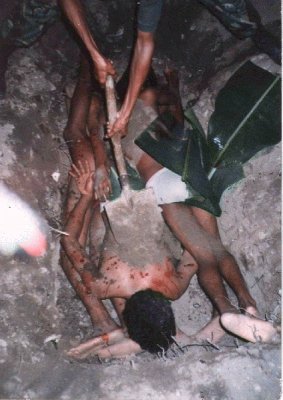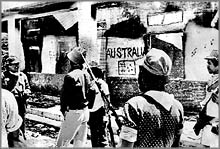|
|
|
The
Untold Story Of The Balibo Five By Tom Hyland (Pictures show house in which Balibo five bodies were found and a shallow grave for young Timorese killed by Indonesian soldiers - "I did not meet any East Timorese who hadn't lost family and friends. As Colonel Gatot Purwanto, the occupation intelligence chief, confirmed, the Indonesian armed forces have killed roughly one-third of the East Timorese population.") The depressing saga of Australian efforts to establish the fate of the five Australia-based TV reporters killed in Balibo illustrates the bind that Australian diplomats had created for themselves. They knew Indonesian forces carried out the attack on Balibo and had been warned by Harry Tjan, the director of the quasi-academic think tank that was their key source of information on Indonesia's intentions towards Portuguese Timor. But they wouldn't say so publicly, for fear of cutting off their source and jeopardising relations with Jakarta. On October 13, 1975, Tjan told the Australian embassy in Jakarta that Indonesian forces were finally about to enter the territory. The main thrust would begin on October 15, through Balibo and Maliana/Atsabe. President Suharto had insisted "no Indonesian flag" be used, giving Jakarta the cloak of deniability. Portuguese Timor's ordeal was about to enter a new and terrible phase. The five journalists had little more than two days to live. In Canberra on October 15, Timor dominated Prime Minister Gough Whitlam's discussions with visiting Malaysian Prime Minister Abdul Razak. Whitlam complained of biased Australian media reporting. The trouble was the reporters had easy access to Dili and Baucau, he said, but didn't go to the border areas, so they gave a one-sided picture. The five reporters, now in Balibo on the border, had only hours to live. On the morning of October 16, Indonesian troops disguised as Timorese anti-Fretilin forces attacked Balibo. The five reporters were killed. In the documents released yesterday, the first reference to the journalists' fate is a transcript of an ABC news item on October 17, reporting the journalists were missing. The transcript was sent to the embassy in Jakarta, requesting urgent inquiries. So began extraordinary efforts by Australian diplomats to establish what happened to the journalists, which at times bordered on farcical charade. As well as not wanting to jeopardise their Indonesian sources, the diplomats wouldn't compromise more secret sources. It is known Australian intelligence agencies that intercepted Indonesian radio traffic were aware of the deaths on October 16, and that the Federal Government was informed that night. All references to intelligence material have been expunged from the documents. On October 17, when Gerald Stone of Channel Nine rang the embassy asking if it had more information on the journalists, he was told nothing more was available. The Indonesian Foreign Ministry and Tjan both told the embassy that any information on Balibo would have to come from anti-Fretilin forces, in line with the fiction that Jakarta was not involved in the Balibo operation. "We said we understood this completely," the embassy said in a cable on October 17. The following day ambassador Richard Woolcott cabled Canberra: "As you will know (half a line of intelligence material is expunged) it now appears likely that at least four and possible all five of the Australian journalists were killed in the fighting in and around Balibo." If true, this was a "sad and dreadful development". The cable made no other reference to remorse for the journalists or their families. Rather, Woolcott was concerned about the risk of "serious consequences" if Australian public opinion was inflamed "if it appears that Australian casualties are the result of Indonesian intervention". The cable went on to shift blame for the reporters' fate, pointing the finger at Canberra's responsibility to alert Australians to the dangers of the border area. Woolcott's cable prompted a stinging response from Foreign Affairs head Alan Renouf, who replied personally, complaining about the "tone and language", which was "quite inappropriate and is resented here". On October 19, Woolcott had a frosty encounter with Indonesian Foreign Minister Adam Malik, who was angry and dismissive. Any information on the journalists would have to come from anti-Fretilin forces, not Indonesia, and he raised the question of whether the journalists had worn Fretilin uniforms. In the following weeks, Australian diplomats engaged in a fruitless and humiliating series of representations with Jakarta officials, seeking some confirmation on the fate of the journalists that could satisfy distraught families and an increasing alarmed Australian public. On October 20, Tjan told the embassy that four bodies had been found at Balibo. The embassy passed on the information to Canberra but, because of the source, warned it should not be used in any public statements. Daily the embassy contacted the Indonesian Foreign Ministry, which daily held out hopes for information. "Each day we are disappointed," the embassy reported on October 23. The embassy suspected information on the "missing" journalists could be produced at the "drop of a hat", but said "influential elements", apparently the BAKIN intelligence agency, "are clearly preventing us from receiving it". Eleven days after the reporters' deaths, a BAKIN officer told the embassy they were dead, but this could not be publicly released as it would imply Indonesian involvement in the Balibo attack. Final confirmation of their deaths, if not how they died, came on November 12, when Woolcott met Lieutenant-General Yoga Sugama, head of BAKIN, who handed over four boxes of remains. The embassy doctor "confirmed to the best of his knowledge they were human remains".
Balibo
Documents 'Almost Funny' says Widow Shackleton Perth The widow of murdered Australian reporter Greg Shackleton today described newly-released documents about the 1975 killings of [four Australians and a New Zealander] in East Timor as "almost funny" and "Basil Fawlty-ish". Foreign Minister Alexander Downer today released almost 900 pages of confidential diplomatic cables which showed Australia knew of Indonesia's plan to invade East Timor through Balibo three days before the newsmen died. Shirley Shackleton said she had not seen the documents but believed some vital details had been withheld. "It makes me suspect the ones (documents) that were withdrawn must be dynamite," Mrs Shackleton said. "It's bizarre. It's almost funny. It's Basil Fawlty-ish." Mrs Shackleton said the government should have acted to ensure the men's safety immediately upon learning of the imminent invasion. "What should have been done was for Mr Whitlam to tell the Indonesian ambassador Mr Woolcott to go to the Indonesians and say 'the Australian and British men are in Balibo, see that they're not hurt'. "It was as simple as that. They shouldn't have even had to have fought for a minute. "It would've been bad enough if they'd done nothing, but what they've done was tell lies. "It's time to put an end to the farce and get real. "It's comforting to think we've got them on the run in that they felt they needed to do something (but) they're still covering up and carrying on with the same pantomime". Greg Shackleton, a Channel Seven reporter, was among the five newsmen who had gone to Balibo to check out reports of Indonesian troops in the area. He was killed along with Seven sound recordist Tony Stewart and cameraman Gary Cunningham from New Zealand, and Channel Nine crew Malcolm Rennie and cameraman Brian Peters, both British citizens... nd to poverty. These foot-soldiers are mobilisi |


